The Essential Guide to Psychological Safety in 2025
In 2025, organizations that neglect psychological safety risk falling behind in both innovation and employee engagement. Teams with high psychological safety outperform others and experience far less conflict. This essential guide explains what psychological safety means in today’s workplace, why it is more critical than ever, and how leaders can build and sustain it for future success.
You’ll discover its definition, evolution, measurable business impact, the latest trends, and actionable steps to cultivate a thriving culture. Ready to unlock your organization’s full potential? Dive in, and start future-proofing your workplace with proven strategies.
Understanding Psychological Safety: Definition, History, and Core Concepts
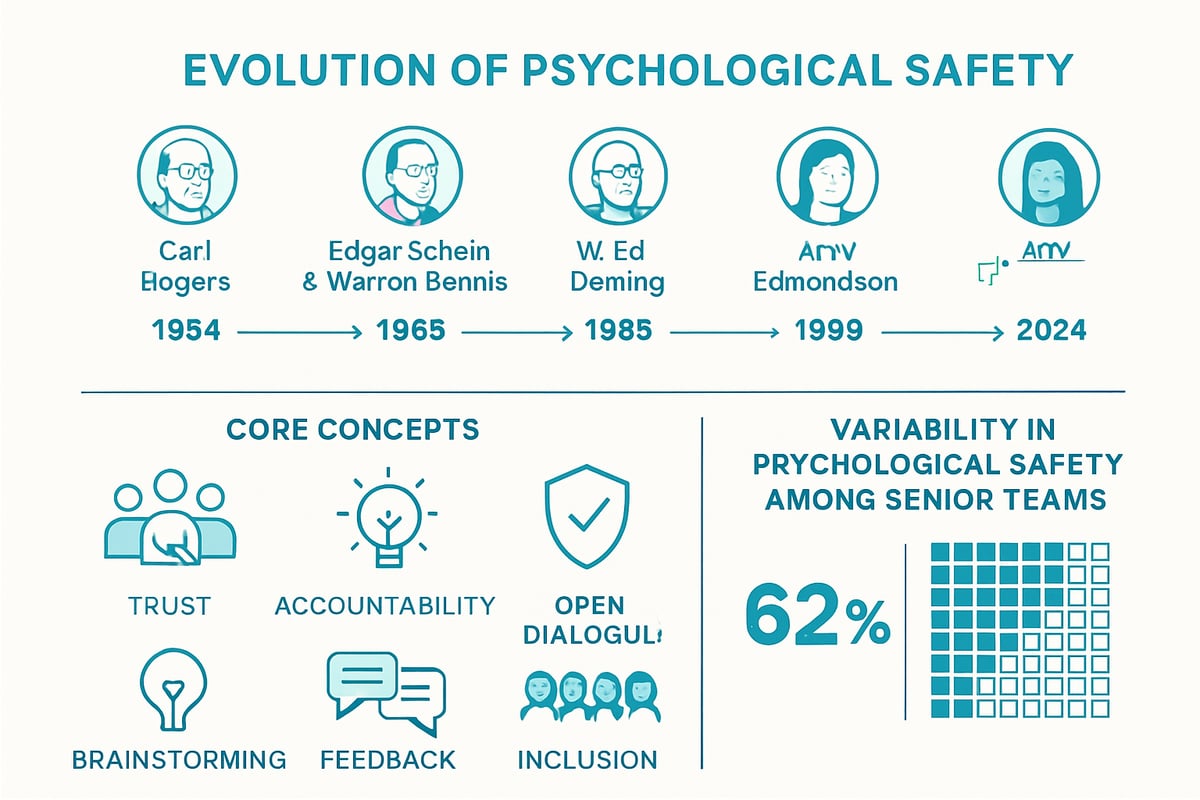
What Is Psychological Safety?
Psychological safety is the belief that you can speak up with ideas, questions, concerns, or even mistakes without fear of punishment or humiliation. This concept is not just about individual comfort; it is a group-level phenomenon where shared expectations allow for risk-taking without negative consequences.
Key characteristics of psychological safety include open communication, group norms that welcome challenge, and the freedom to admit errors. Unlike trust, which is mostly about one-on-one relationships, psychological safety is about group dynamics and immediacy. For example, Google’s Project Aristotle identified psychological safety as the top factor in effective teams, a finding reinforced by research on learning in teams.
Historical Evolution and Key Theorists
The roots of psychological safety trace back to Carl Rogers in the 1950s, who emphasized creativity and acceptance. Edgar Schein and Warren Bennis expanded the idea in the 1960s, focusing on organizational change and group dynamics. In 1982, W.E. Deming’s “drive out fear” principle highlighted the need to eliminate fear to improve quality.
Amy Edmondson’s research in the 1990s made psychological safety central to team learning and performance. Over time, the focus shifted from just physical safety to psychological safety as a core of workplace culture. This evolution shows that fostering open, supportive environments is crucial for growth.
Psychological Safety vs. Accountability and Other Constructs
Psychological safety should not be confused with accountability. While psychological safety allows people to speak up, accountability ensures performance standards are upheld. The key is balancing candor with clear expectations.
Comparing psychological safety to trust reveals another distinction. Trust is often about long-term, one-to-one relationships, while psychological safety is immediate and collective. A common misconception is that psychological safety means always being “nice,” when in reality, it is about respectful challenge and open disagreement. Some teams mistakenly believe psychological safety means avoiding standards, but real safety thrives alongside accountability.
| Construct | Focus | Level | Timeframe |
|---|---|---|---|
| Psychological Safety | Speaking up | Group | Immediate |
| Trust | Reliability | Dyadic | Long-term |
| Accountability | Performance | Group | Ongoing |
How Psychological Safety Manifests in Teams and Organizations
You can observe psychological safety in action through behaviors like open dialogue, sharing rough ideas, and giving constructive feedback. Teams that handle failure, disagreement, and experimentation with curiosity rather than blame create a safe environment.
Norms that encourage learning from mistakes and support experimentation are central to psychological safety. For marginalized or underrepresented groups, psychological safety can be harder to achieve, as some may worry about standing out or being judged. According to a CCL study, 62% of senior teams report significant variability in psychological safety, highlighting the need for consistent, inclusive practices.
The Business Case: The Impact and Benefits of Psychological Safety in 2025
Building a strong business case for psychological safety is essential for organizations aiming to thrive in 2025. As workplaces become more dynamic, the measurable impact of psychological safety on performance, innovation, and well-being is clearer than ever.
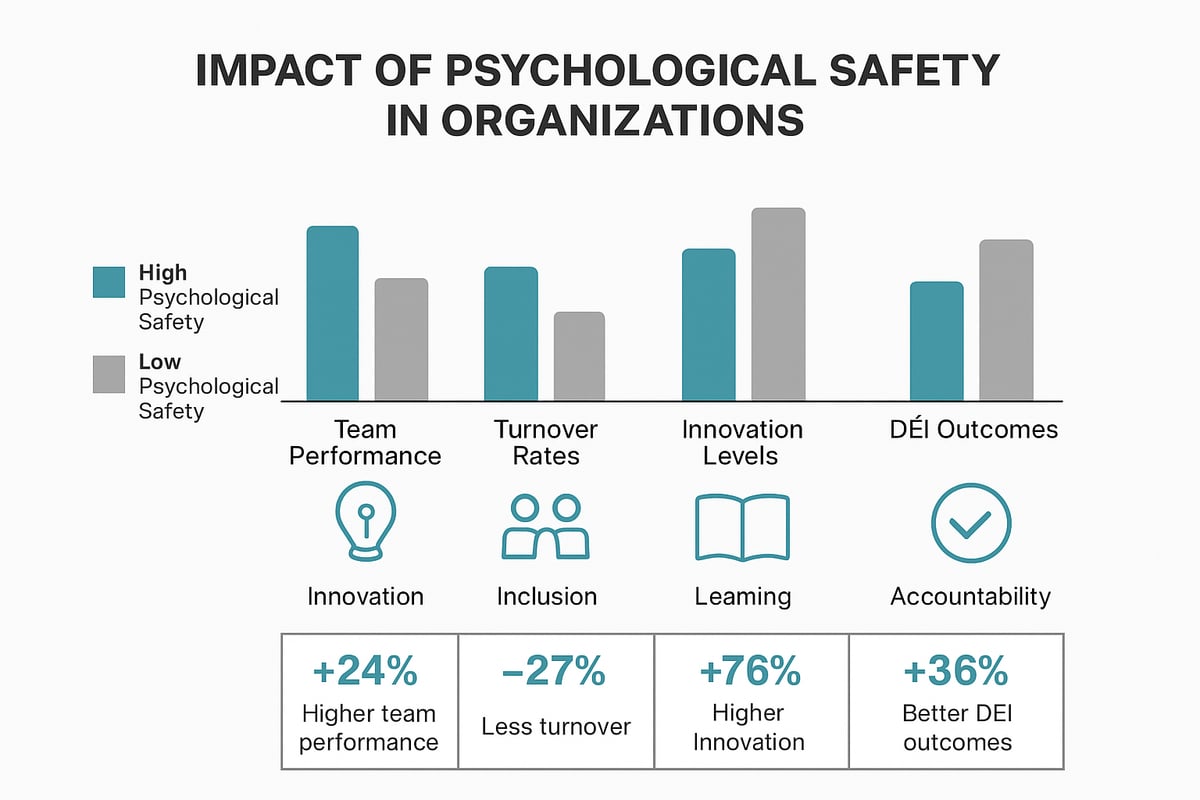
Measurable Outcomes and Organizational Performance
Psychological safety is a proven driver of organizational success. Teams that foster psychological safety experience higher levels of creativity, faster problem-solving, and greater engagement. According to the Center for Creative Leadership, teams with high psychological safety report improved performance and significantly lower conflict.
| Outcome | High Psychological Safety | Low Psychological Safety |
|---|---|---|
| Innovation | High | Low |
| Team Engagement | High | Low |
| Turnover Rates | Low | High |
| Interpersonal Conflict | Low | High |
These outcomes are not just anecdotal. A comprehensive meta-analysis on psychological safety and innovation found a direct, positive link between psychological safety and innovation behavior, reinforcing its value for future-focused organizations. For more on building accountability alongside safety, see Accountability Now.
Diversity, Inclusion, and Psychological Safety
Psychological safety is the foundation for meaningful diversity, equity, and inclusion (DEI) initiatives. When psychological safety is present, employees from all backgrounds feel empowered to contribute their perspectives. This is critical, as Gallup reports only three out of ten employees believe their opinions count at work.
Hybrid and remote work models can amplify existing barriers, making it harder for underrepresented voices to be heard. Psychological safety bridges these gaps by ensuring everyone, regardless of identity, can participate fully and authentically. Organizations embracing these principles attract and retain top talent in an increasingly competitive landscape.
Learning from Mistakes and Failure
Organizations that prioritize psychological safety treat mistakes as learning opportunities. When people are not afraid to admit errors or ask questions, experimentation flourishes. This approach is vital in the fast-paced environments of 2025, where agility and continuous learning are key.
A classic example is the Toyota Production System’s Andon Cord, which empowers any employee to stop the production line if a problem arises. Such practices reinforce psychological safety and fuel ongoing improvement. Teams that learn from failure become more resilient and adaptive, positioning themselves for long-term success.
Drawbacks and Limitations
While psychological safety is a powerful force, it must be balanced with accountability. Too much focus on comfort can sometimes lead to complacency or reduced motivation. There is also a risk that psychological safety, if not paired with clear standards, may inadvertently enable unethical behavior or undermine performance expectations.
To maximize benefits, leaders must maintain high standards while promoting open dialogue. The most effective organizations set clear goals and encourage respectful challenge, ensuring psychological safety supports—not replaces—accountability and excellence.
The State of Psychological Safety in 2025: Trends, Challenges, and Opportunities
The landscape of psychological safety continues to evolve rapidly in 2025. As organizations adapt to hybrid work, technological disruption, and shifting workforce expectations, psychological safety stands as the linchpin for sustainable performance and well-being. Let’s break down the most pressing trends, challenges, and opportunities shaping psychological safety this year.
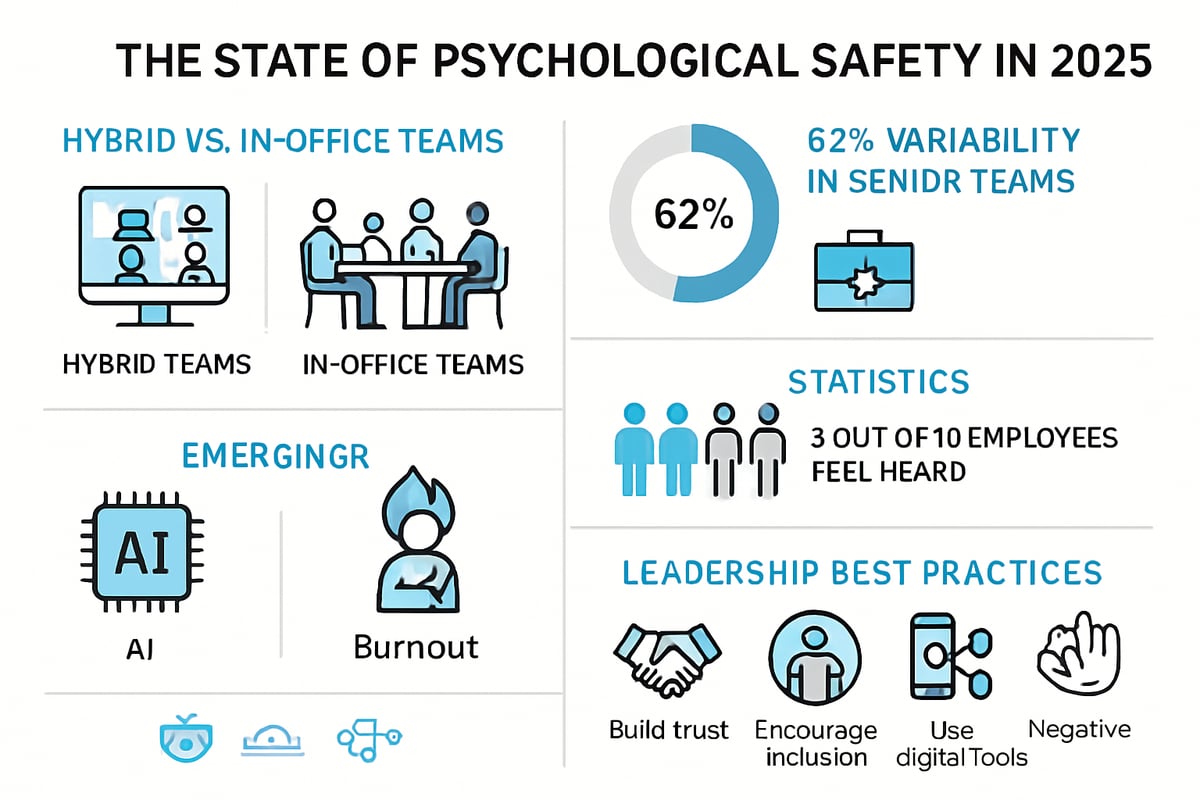
The Hybrid and Remote Work Revolution
Hybrid and remote work have fundamentally changed how psychological safety is built and maintained. Virtual interactions can create both barriers and new pathways for authentic expression. Teams must overcome the lack of physical cues and informal chats, which traditionally fostered trust.
Conversely, digital platforms open up unique opportunities. Written chat functions and asynchronous communication can encourage quieter voices to participate, making psychological safety more accessible for some. For example, many employees now feel more comfortable sharing concerns in meeting chats rather than speaking up verbally.
Building psychological safety in a dispersed team requires intentional design of communication norms, regular check-ins, and leveraging technology to create inclusive spaces.
Emerging Risks and Organizational Pressures
Economic uncertainty and rapid industry shifts heighten the need for psychological safety, but also introduce new risks. Burnout and disengagement are common in environments where psychological safety is low, especially as workloads increase and resources tighten.
Organizational pressures can disproportionately impact marginalized groups. According to a Catalyst survey, nearly half of female business leaders report difficulty speaking up in virtual meetings, reflecting ongoing equity challenges. When psychological safety is lacking, talented individuals may withhold ideas or exit the organization, stifling innovation and growth.
Addressing these risks requires leaders to be proactive, recognizing warning signs and fostering open dialogue about stress and workload.
Evolving Leadership Expectations
In 2025, leaders are expected to actively model vulnerability and facilitate candid conversations. Leadership is no longer about top-down control, but about empowering teams to challenge assumptions and surface new ideas. Inclusive leadership practices are now recognized as essential drivers of psychological safety.
Recent research highlights that leadership style directly shapes the psychosocial safety climate within organizations. For deeper insights, see Leadership’s Impact on Psychological Safety. Leaders who show transparency and invite feedback set the stage for teams to thrive, adapt, and innovate.
Technology, AI, and Data Privacy
The rise of AI-driven analytics and digital monitoring brings both promise and peril for psychological safety. While technology can help identify team sentiment and flag emerging issues, it can also fuel concerns about surveillance and privacy.
Balancing transparency with autonomy is paramount. Psychological safety flourishes when employees trust that feedback systems and AI tools are used ethically, with clear communication about data use. For example, organizations deploying AI for team health indicators must establish strong privacy policies and ensure employees feel secure in sharing honest feedback.
In this environment, leaders must champion ethical standards and involve teams in decisions about technology adoption.
Measuring and Diagnosing Psychological Safety
Measuring psychological safety has become more sophisticated, with organizations leveraging pulse surveys, focus groups, and team health dashboards. Quantitative tools allow leaders to track trends, while qualitative feedback uncovers deeper insights.
Regular assessment helps organizations pinpoint gaps and target interventions. For instance, pulse surveys can reveal whether employees feel safe experimenting or voicing concerns. These tools are essential for continuous improvement, ensuring psychological safety adapts alongside organizational change.
To build a resilient, future-ready culture, organizations must integrate measurement into their DNA and act on findings.
The Four Stages of Psychological Safety: A Framework for Growth
Understanding the four stages of psychological safety helps organizations intentionally move teams from basic acceptance to high-level innovation. This framework clarifies how psychological safety evolves, supporting growth at every step. Each stage matters, and teams must progress through each to unlock full potential.
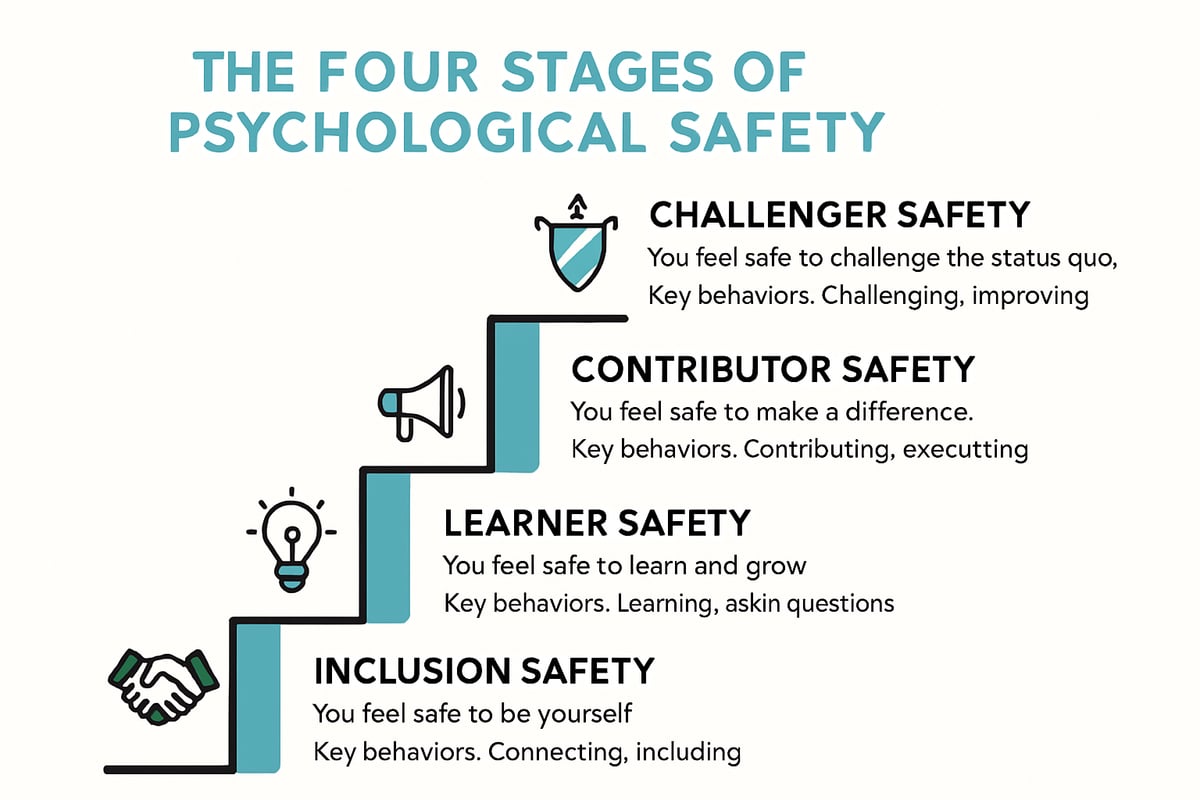
Stage 1: Inclusion Safety
Inclusion safety is the foundation of psychological safety. At this stage, every team member feels accepted and valued for who they are, regardless of role or background.
Behaviors that foster inclusion safety include:
- Welcoming diverse perspectives in meetings
- Proactive onboarding for new hires
- Pairing employees with mentors
These actions help remove barriers for marginalized or new team members. Structured check-ins and buddy systems ensure everyone feels seen and heard. When inclusion safety is present, people bring their whole selves to work, setting the stage for deeper engagement.
Stage 2: Learner Safety
Learner safety means team members feel comfortable asking questions, experimenting, and making mistakes without fear of negative consequences. This stage of psychological safety is crucial for growth and continuous improvement.
Teams can build learner safety by:
- Encouraging questions and curiosity
- Holding debriefs after projects or setbacks
- Celebrating lessons learned from failures
Retrospective meetings and open knowledge sharing help normalize learning from mistakes. By treating failure as an opportunity, organizations create “failure-friendly” environments that accelerate collective learning and adaptability.
Stage 3: Contributor Safety
Contributor safety empowers individuals to actively participate, share ideas, and take initiative. At this level of psychological safety, people know their contributions matter and are respected by the team.
Ways to promote contributor safety include:
- Organizing regular brainstorming sessions
- Offering open feedback channels
- Recognizing and rewarding proactive problem-solving
Crowdsourcing solutions for organizational challenges also boosts contributor safety. When teams feel safe to contribute, innovation and engagement soar. Want to learn more about building this culture? Visit Accountability Now for expert insights.
Stage 4: Challenger Safety
Challenger safety is the highest stage of psychological safety, where team members can question the status quo and offer dissenting views. Leaders play a vital role in modeling openness to constructive criticism and debate.
Practices that encourage challenger safety:
- Assigning devil’s advocate roles during discussions
- Hosting open Q&A sessions with executives
- Creating forums for respectful debate
Organizations that innovate consistently invite challenge and support truth-telling. Leadership coaching is especially effective for developing these skills—explore more in Leadership Coaching and Psychological Safety.
Eight Steps to Building and Sustaining Psychological Safety
Creating psychological safety is not a one-time initiative, but a continuous journey. Organizations that excel at psychological safety follow a clear roadmap. Here are eight essential steps to foster, embed, and scale psychological safety for high-performing, resilient teams.
Step 1: Make Psychological Safety an Explicit Priority
Leadership must declare psychological safety as a core value. This means integrating it into vision statements, values, and strategic goals. When leaders clearly communicate that psychological safety is non-negotiable, teams understand its importance.
Linking psychological safety to both innovation and well-being sends a powerful message. For example, executive town halls that address psychological safety show visible commitment. Leaders should reference psychological safety in all-hands meetings, linking it to long-term organizational success.
Step 2: Facilitate Everyone Speaking Up
Every voice counts. Organizations should create structures that ensure everyone can contribute, regardless of role or background. Techniques like round robins or anonymous digital input help level the playing field.
Leaders must practice active listening and genuine curiosity. A coaching culture, where managers are trained to ask questions and honor candor, dramatically increases psychological safety. For teams seeking outside help, team coaching for psychological safety can accelerate these results.
Step 3: Establish Norms for Handling Failure
Mistakes should be seen as opportunities for learning, not grounds for blame. Psychological safety thrives when teams are encouraged to experiment and share lessons from failure.
Organizations can publicly share stories of recovery, or even create a “failure wall” to normalize risk-taking. This builds a culture where psychological safety allows people to innovate without fear of negative consequences.
Step 4: Model Vulnerability and Openness as a Leader
Leaders set the tone for psychological safety by being transparent about their own limitations. When managers admit mistakes or ask for help, it signals that vulnerability is safe.
Inviting feedback and welcoming critique are critical. Leaders who share their learning journeys help teams see that psychological safety is not about perfection, but honest growth.
Step 5: Build Trust and Foster Team Cohesion
Trust is the backbone of psychological safety. Teams build trust through shared experiences, transparent decision-making, and reliability.
Consistently following through on commitments reinforces psychological safety. Research shows that trust is a significant antecedent of psychological safety, highlighting the importance of investing in team relationships. For practical strategies, visit Accountability Now.
Step 6: Address Social Identity and Inclusion Gaps
True psychological safety requires deliberate action to remove barriers for marginalized team members. Training on unconscious bias, microaggressions, and inclusive behaviors is essential.
Creating safe spaces for underrepresented voices and tracking participation in meetings ensures that psychological safety is experienced by everyone. Data shows that one in five women feel overlooked during video calls, so organizations must be proactive in fostering inclusion.
Step 7: Continuously Measure and Adapt
Psychological safety is dynamic. Regularly using surveys, pulse checks, and feedback loops helps organizations track progress and address problem areas.
Leaders should analyze both quantitative and qualitative data to spot trends. Adapting strategies as teams evolve is key to maintaining psychological safety in changing environments.
Step 8: Sustain and Scale Psychological Safety Across the Organization
To embed psychological safety for the long term, organizations must integrate it into hiring, onboarding, and performance management. Sharing stories of success and aligning incentives with safe behaviors helps psychological safety spread beyond individual teams.
Leadership development programs and organization-wide initiatives ensure psychological safety becomes part of the culture, not just a temporary project.
Case Studies and Real-World Examples: Psychological Safety in Action
Psychological safety is more than a theory, it’s a living, measurable driver of performance in organizations worldwide. Let’s explore how leading companies and industries put psychological safety into practice, what happens when it’s absent, and the lessons you can apply to your own teams.
Google’s Project Aristotle
Google’s Project Aristotle stands as one of the most cited examples of psychological safety in action. The company studied hundreds of teams and discovered that psychological safety was the single most important factor for effectiveness. Teams with high psychological safety openly shared ideas, admitted mistakes, and debated solutions without fear. This environment fueled innovation and boosted retention rates. According to research on inclusive leadership and innovation, organizations that support psychological safety see higher levels of creative problem-solving and sustainable growth. When psychological safety is prioritized, teams consistently outperform their peers.
Healthcare: Reducing Medical Errors
In healthcare, psychological safety can have life-or-death implications. Hospitals that foster psychological safety encourage staff to speak up about mistakes, near-misses, or process gaps. This openness reduces medical errors and improves patient safety. For example, operating room teams that feel safe to voice concerns are less likely to make critical errors. Psychological safety also supports a learning culture, where debriefings and open discussions drive continuous improvement. The result is not only fewer adverse events, but also higher staff morale and trust. Healthcare organizations that embed psychological safety into their culture become models for transparency and accountability.
Technology and Hybrid Teams
The rise of hybrid and remote work has made psychological safety both more challenging and more essential. Virtual teams often struggle with miscommunication and the absence of nonverbal cues. However, organizations that intentionally create space for open dialogue—through regular check-ins, transparent agendas, and chat channels—see greater engagement and innovation. For instance, digital tools enable team members to share half-formed ideas or feedback in a safe environment. These practices help bridge the gap between physical and digital workspaces. Companies that master psychological safety in virtual settings adapt faster and retain top talent.
Lessons from Failure: When Psychological Safety Is Lacking
The absence of psychological safety can have costly consequences. Teams where concerns go unspoken or dissent is discouraged often miss critical warnings, leading to failed projects or disengaged employees. One notable example involved a tech firm where employees hesitated to challenge decisions, resulting in a missed market opportunity. After recognizing the issue, the organization took steps to rebuild team trust in the workplace and reestablish psychological safety. By investing in open communication and accountability, they turned failure into a catalyst for long-term growth.
Future-Proofing Psychological Safety: Strategies for 2025 and Beyond
The workplace in 2025 faces constant change, rapid digital transformation, and new demands on leaders and teams. To stay ahead, organizations must embed psychological safety into every layer of their culture and strategy. Here’s how forward-thinking companies can future-proof psychological safety for lasting success.
Integrating Psychological Safety into Leadership Development
Developing leaders who champion psychological safety is essential for scalable culture change. Training and coaching programs must prioritize vulnerability, feedback, and inclusive behaviors.
Organizations are embedding psychological safety into leadership competencies, making it a core focus of executive development. Coaching sessions, peer feedback, and scenario-based learning help leaders model openness and candor.
To avoid the pitfalls of toxic leadership, companies should learn from resources like the Effects of Toxic Leadership on Safety, which highlights why positive leadership is critical for psychological safety. For additional support, consider trusted partners such as Accountability Now for organizational guidance.
Leveraging Technology and Data Responsibly
Technology is transforming how organizations monitor and nurture psychological safety. AI-powered sentiment analysis, pulse surveys, and digital feedback platforms offer real-time insights into team dynamics.
However, responsible use is crucial. Employees must trust that data collection is ethical, transparent, and respects privacy. Leaders should communicate clearly about how AI tools are used, focusing on support rather than surveillance.
By using technology as an enabler, not a threat, organizations strengthen psychological safety and build trust across hybrid and remote teams.
Aligning Psychological Safety with Organizational Strategy
Leading companies now treat psychological safety as a key performance indicator. By linking it directly to innovation, retention, and business outcomes, they ensure it is not an afterthought but a driver of strategic success.
Executives should set clear expectations, measure progress, and reward behaviors that support psychological safety. Integrating safety into hiring, onboarding, and performance processes helps embed it into organizational DNA.
Strategic alignment makes psychological safety sustainable, supporting growth and adaptability in any market condition.
Navigating Ongoing Change and Uncertainty
Constant change is the new normal, so resilient teams must adapt quickly. Psychological safety enables teams to learn from setbacks, speak up about risks, and experiment without fear.
Organizations can build resilience by fostering open dialogue, supporting continuous learning, and preparing for new challenges like AI disruption or global crises. Regular check-ins and transparent communication keep teams connected and empowered.
By prioritizing psychological safety, companies create a foundation for agility and success in uncertain times.
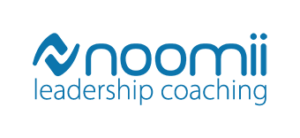
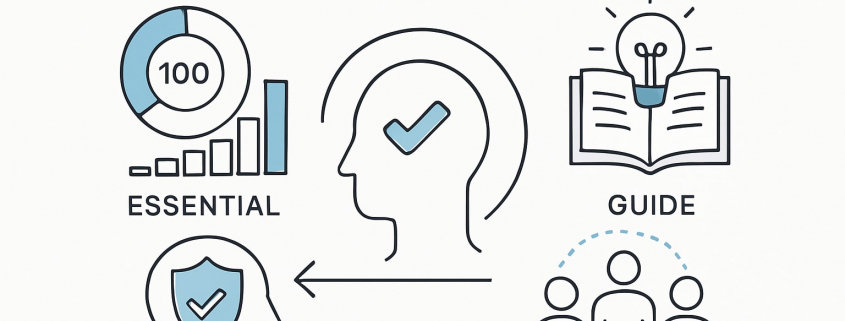


Leave a Reply
Want to join the discussion?Feel free to contribute!